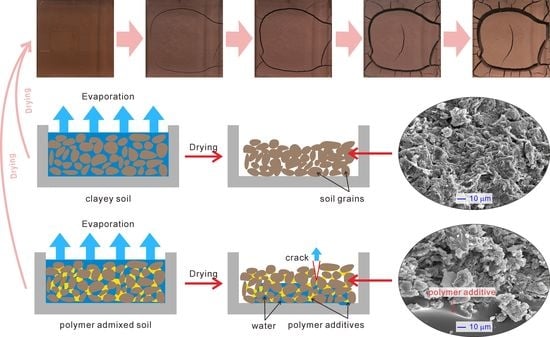Desiccation Cracking Behavior of Polyurethane and Polyacrylamide Admixed Clayey Soils
Abstract
1. Introduction
2. Materials and Methods
2.1. Materials
2.2. Sample Preparation and Test method
2.3. Image Processing and Quantitative Analysis
- Crack intensity factor (CIF) refers to the ratio of plane cracks area to the total area of the sample. The higher the value of CIF, the greater the degree of surficial cracking.
- Number of nodes (Nn) and number of cracks (Nc). The skeleton line between two adjacent nodes on the skeleton is considered as a crack (Figure 2e). In general, Nn and Nc can reflect the cracked degree of sample surface.
- Average length of cracks (Lav) and average width of cracks (Wav). The crack length was determined by calculating the distance between intersections on the skeleton (Figure 2e). The crack width was determined by calculating the shortest distance from a randomly selected point on one boundary to the opposite boundary of the crack segment.
- Number of clods (Ncl) and average area of clods (Aav). The clod refers to the independent closed area which is split by crack, that is, the closed white area in Figure 2c,d.
- Probability density function (PDF) of crack length f(L), crack width f(W), and clods area f(A), which could help analyzing the distribution characteristics of crack length, width, and clod area from the statistical level and providing more reliable results. Setting the PDF of crack length f(L) as an example, it is defined as:where Nc is the total number of cracks and ∆Nci is the number of cracks whose length ranges between Li + ∆L. f(L) refers to the percentage of cracks number whose length ranges between Li + ∆L to the total cracks number. In this study, the ∆L = 5 mm, ∆W = 0.5 mm, ∆A = 100 mm2 was chosen for the PDF of f(L), f(W), and f(A) respectively.
2.4. Microstructure Observation
3. Results
3.1. Evaporation Characteristic
3.2. Crack Propagation and Pattern
3.3. Characterization of Crack and Clod
3.4. Microstructure Characteristics
4. Discussion
5. Conclusions
Author Contributions
Funding
Conflicts of Interest
References
- Liu, J.; Bai, Y.; Song, Z.; Lu, Y.; Qian, W.; Kanungo, D.P. Evaluation of strength properties of sand modified with organic polymers. Polymers 2018, 10, 287. [Google Scholar] [CrossRef] [PubMed]
- Rezaeimalek, S.; Huang, J.; Bin-Shafique, S. Evaluation of curing method and mix design of a moisture activated polymer for sand stabilization. Constr. Build. Mater. 2017, 146, 210–220. [Google Scholar] [CrossRef]
- Ajalloeian, R.; Matinmanesh, H.; Abtahi, S.M.; Rowshanzamir, M. Effect of polyvinyl acetate grout injection on geotechnical properties of fine sand. Geomech. Geoeng. 2013, 8, 86–96. [Google Scholar] [CrossRef]
- Mamedov, A.I.; Wagner, L.E.; Huang, C.; Norton, L.D.; Levy, G.J. Polyacrylamide effects on aggregate and atructure stability of soils with different clay mineralogy. Soil Sci. Soc. Am. J. 2010, 74, 1720–1732. [Google Scholar] [CrossRef]
- Georgees, R.N.; Hassan, R.A.; Evans, R.P.; Jegatheesan, P. Effect of the use of a polymeric stabilizing additive on unconfined compressive strength of soils. Transp. Res. Rec. 2015, 2473, 200–208. [Google Scholar] [CrossRef]
- Saleh, S.; Yunus, N.Z.M.; Ahmad, K.; Ali, N. Improving the strength of weak soil using polyurethane grouts a review. Constr. Build. Mater. 2019, 202, 738–752. [Google Scholar] [CrossRef]
- Theng, B.K.G. Interactions of clay minerals with organic polymers. some practical applications. Clay Clay Miner. 1970, 18, 357–362. [Google Scholar] [CrossRef]
- Gao, W.; Wu, Z.; Wu, Z. Study of mechanism of the W-OH sand fixation. J. Environ. Prot. Ecol. 2012, 3, 1025–1033. [Google Scholar] [CrossRef]
- Naeini, S.A.; Naderinia, B.; Izadi, E. Unconfined compressive strength of clayey soils stabilized with waterborne polymer. KSCE J. Civ. Eng. 2012, 16, 943–949. [Google Scholar] [CrossRef]
- Xiao, Y.; Stuedlein, A.W.; Chen, Q.S.; Liu, H.; Liu, P. Stress-strain-strength response and ductility of gravels improved by polyurethane foam adhesive. J. Geotech. Geoenviron. 2018, 144, 04017108. [Google Scholar] [CrossRef]
- Liu, J.; Chen, Z.; Song, Z.; Bai, Y.; Qian, W.; Wei, J.; Kanungo, D.P. Tensile behavior of polyurethane organic polymer and polypropylene fiber-reinforced sand. Polymers 2018, 10, 499. [Google Scholar] [CrossRef] [PubMed]
- Deng, Y.; Liu, S.; Huang, J.; Li, K.; Du, Y.; Jing, F. Strength and permeability of cemented soil with PAM. In Proceedings of the Fourth International Conference on Grouting and Deep Mixing 2012, New Orleans, LA, USA, 15–18 February 2012; pp. 1800–1807. [Google Scholar] [CrossRef]
- Li, Y.; Shao, M.; Horton, R. Effect of polyacrylamide applications on soil hydraulic characteristics and sediment yield of sloping land. Procedia Environ. Sci. 2011, 11, 763–773. [Google Scholar] [CrossRef]
- Liu, J.; Chen, Z.; Kanungo, D.P.; Song, Z.; Bai, Y.; Wang, Y.; Li, D.; Qian, W. Topsoil reinforcement of sandy slope for preventing erosion using water-based polyurethane soil stabilizer. Eng. Geol. 2019, 252, 125–135. [Google Scholar] [CrossRef]
- Liu, J.; Shi, B.; Jiang, H.; Huang, H.; Wang, G.; Kamai, T. Research on the stabilization treatment of clay slope topsoil by organic polymer soil stabilizer. Eng. Geol. 2011, 117, 114–120. [Google Scholar] [CrossRef]
- Vennapusa, P.K.R.; Zhang, Y.; White, D.J. Comparison of pavement slab stabilization using cementitious grout and injected polyurethane foam. J. Perform. Constr. Facil. 2016, 30, 04016056. [Google Scholar] [CrossRef]
- Mohamed Jais, I.B. Rapid remediation using polyurethane foam/resin grout in Malaysia. Geotech. Res. 2017, 4, 107–117. [Google Scholar] [CrossRef]
- Zhang, X.; Yu, X.; Guo, Y.; Fan, X. Behaviors of expansive soils mixed with polymeric stabilizing foams. In Proceedings of the Eighth International Conference on Case Histories in Geotechnical Engineering, Philadelphia, PA, USA, 24–27 March 2019. [Google Scholar]
- Tang, C.; Shi, B.; Liu, C.; Gao, L.; Inyang, H.I. Experimental investigation of the desiccation cracking behavior of soil layers during drying. J. Mater. Civ. Eng. 2011, 23, 873–878. [Google Scholar] [CrossRef]
- Lozada, C.; Caicedo, B.; Thorel, L. Effects of cracks and desiccation on the bearing capacity of soil deposits. Geotech. Lett. 2015, 5, 112–117. [Google Scholar] [CrossRef]
- Costa, S.; Kodikara, J.; Shannon, B. Salient factors controlling desiccation cracking of clay in laboratory experiments. Geotechnique 2013, 63, 18–29. [Google Scholar] [CrossRef]
- Morris, P.H.; Graham, J.; Williams, D.J. Cracking in drying soils. Can. Geotech. J. 1992, 29, 263–277. [Google Scholar] [CrossRef]
- Tang, C.; Shi, B.; Liu, C.; Zhao, L.; Wang, B. Influencing factors of geometrical structure of surface shrinkage cracks in clayey soils. Eng. Geol. 2008, 101, 204–217. [Google Scholar] [CrossRef]
- Rayhani, M.H.T.; Yanful, E.K.; Fakher, A. Desiccation-induced cracking and its effect on the hydraulic conductivity of clayey soils from Iran. Can. Geotech. J. 2007, 44, 276–283. [Google Scholar] [CrossRef]
- Tang, C.; Shi, B.; Cui, Y.; Liu, C.; Gu, K. Desiccation cracking behavior of polypropylene fiber–reinforced clayey soil. Can. Geotech. J. 2012, 49, 1088–1101. [Google Scholar] [CrossRef]
- Baker, R. Tensile strength, tension cracks, and stability of slopes. Soils Found. 1981, 21, 1–17. [Google Scholar] [CrossRef]
- Li, J.; Li, L.; Chen, R.; Li, D. Cracking and vertical preferential flow through landfill clay liners. Eng. Geol. 2016, 206, 33–41. [Google Scholar] [CrossRef]
- Li, J.; Zhang, L. Study of desiccation crack initiation and development at ground surface. Eng. Geol. 2011, 123, 347–358. [Google Scholar] [CrossRef]
- Perrier, E.; Mullon, C.; Rieu, M. Computer construction of fractal soil structures: Simulation of their hydraulic and shrinkage properties. Water Resour. Res. 1995, 31, 2927–2943. [Google Scholar] [CrossRef]
- Wopereis, M.C.S.; Bouma, J.; Kropff, M.J.; Sanidad, W. Reducing bypass flow through a dry, cracked and previously puddle rice soil. Soil Tillage Res. 1994, 29, 1–11. [Google Scholar] [CrossRef]
- Zein el Adebine, A.; Robinson, G.H. A study on cracking in some Vertisols of the Sudan. Geoderma 1971, 5, 229–241. [Google Scholar] [CrossRef]
- Miller, C.J.; Mi, H.; Yesiller, N. Experimental analysis of desiccation crack propagation in clay liners. J. Am. Water Resour. Assoc. AWRA 1998, 34, 677–686. [Google Scholar] [CrossRef]
- Velde, B. Structure of surface cracks in soil and muds. Geoderma 1999, 93, 101–112. [Google Scholar] [CrossRef]
- Vogel, H.J.; Hofmann, H.; Leopold, A.; Roth, K. Studies of crack dynamics in clay soil: II. A physically based model for crack formation. Geoderma 2005, 125, 213–223. [Google Scholar] [CrossRef]
- Seybold, C.A. Polyacrylamide review: Soil conditioning and environmental fate. Commun. Soil Sci. Plan. 1994, 25, 2171–2185. [Google Scholar] [CrossRef]
- De Melo, D.V.M.; de Almeida, B.G.; de Souza, E.R.; Silva, L.S.; Jacomine, P.K.T. Structural quality of polyacrylamide-treated cohesive soils in the coastal tablelands of Pernambuco. Rev. Bras. Cienc. Solo 2014, 38, 476–485. [Google Scholar] [CrossRef]
- Liu, J.; Bai, Y.; Li, D.; Wang, Q.; Qian, W.; Wang, Y.; Kanungo, D.P.; Wei, J. An experimental study on the shear behaviors of polymer-sand composite materials after immersion. Polymers 2018, 10, 924. [Google Scholar] [CrossRef]
- Mamedov, A.I.; Huang, C.; Aliev, F.A.; Levy, G.J. Aggregate stability and water retention near saturation characteristics as affected by soil texture, aggregate size and polyacrylamide application. Land Degrad. Dev. 2017, 28, 543–552. [Google Scholar] [CrossRef]
- Puppala, A.J.; Katha, B.; Hoyos, L.R. Volumetric shrinkage strain measurement in expansive soils using digital imaging technology. Geotech. Test. J. 2004, 27, 547–556. [Google Scholar] [CrossRef]
- Liu, C.; Wang, B.; Shi, B.; Tang, C. The analysis method of morphological parameters of rock and soil crack based on image processing and recognition. Chin. J. Geotech. Eng. 2008, 30, 1383–1388, (In Chinese with English abstract). [Google Scholar] [CrossRef]
- Zhang, Y.; Gu, K.; Li, J.; Tang, C.; Shen, Z.; Shi, B. Effect of biochar on desiccation cracking characteristics of clayey soils. Geoderma 2020, 364, 114182. [Google Scholar] [CrossRef]
- Tang, C.; Cui, Y.; Shi, B.; Tang, A.M.; Liu, C. Desiccation and cracking behavior of clay layer from slurry state under wetting-drying cycles. Geoderma 2011, 166, 111–118. [Google Scholar] [CrossRef]
- Tang, C.; Shi, B.; Cui, Y. Behaviors and mechanisms of desiccation cracking of soils. Chin. J. Geotech. Eng. 2018, 40, 1415–1423, (In Chinese with English abstract). [Google Scholar] [CrossRef]
- Wu, Z.; Gao, W.; Wu, Z.; Iwashita, K.; Yang, C. Synthesis and characterization of a novel chemical sand-fixing material of hydrophilic polyurethane. J. Soc. Mater. Sci. Jpn. 2011, 60, 674–679. [Google Scholar] [CrossRef]
- Levy, G.; Miller, W. Polyacrylamide adsorption and aggregate stability. Soil Tillage Res. 1999, 51, 121–128. [Google Scholar] [CrossRef]
- Theng, B.K.G. Clay-polymer interactions: Summary and perspectives. Clay Clay Miner. 1982, 30, 1–10. [Google Scholar] [CrossRef]
- Soltani-Jigheh, H.; Bagheri, M.; Amani-Ghadim, A.R. Use of hydrophilic polymeric stabilizer to improve strength and durability of fine-grained soils. Cold Reg. Sci. Technol. 2019, 157, 187–195. [Google Scholar] [CrossRef]
- Miller, W.P.; Willis, R.L.; Levy, G.J. Aggregate stabilization in kaolinitic soils by low rates of anionic polyacrylamide. Soil Use Manag. 1998, 14, 101–105. [Google Scholar] [CrossRef]
- Tang, C.; Shi, B.; Gu, K. Experimental investigation on evaporation process of water in soil during drying. J. Eng. Geol. 2011, 19, 875–881, (In Chinese with English abstract). [Google Scholar]
- Suleman, K.F.; Shahid, A. Determination of the desiccation behavior of clay slurries. Int. J. Min. Sci. Technol. 2017, 27, 981–988. [Google Scholar] [CrossRef]
- Song, W.; Cui, Y.; Tang, A.M.; Ding, W.; Tran, T.D. Experimental study on water evaporation from sand using environmental chamber. Can. Geotech. J. 2014, 51, 115–128. [Google Scholar] [CrossRef]
- Das, N. Preparation methods and properties of hydrogel: A review. Int. J. Pharm. Pharm. Sci. 2013, 5, 112–117. [Google Scholar]
- Gibas, I.; Janik, H. Review: Synthetic polymer hydrogels for biomedical applications. Chem. Chem. Technol. 2010, 4, 297–304. [Google Scholar]
- Muguda, S.; Booth, S.J.; Hughes, P.N.; Augarde, C.E.; Perlot, C.; Bruno, A.W.; Gallipoli, D. Mechanical properties of biopolymer-stabilised soil-based construction materials. Geotech. Lett. 2017, 7, 309–314. [Google Scholar] [CrossRef]
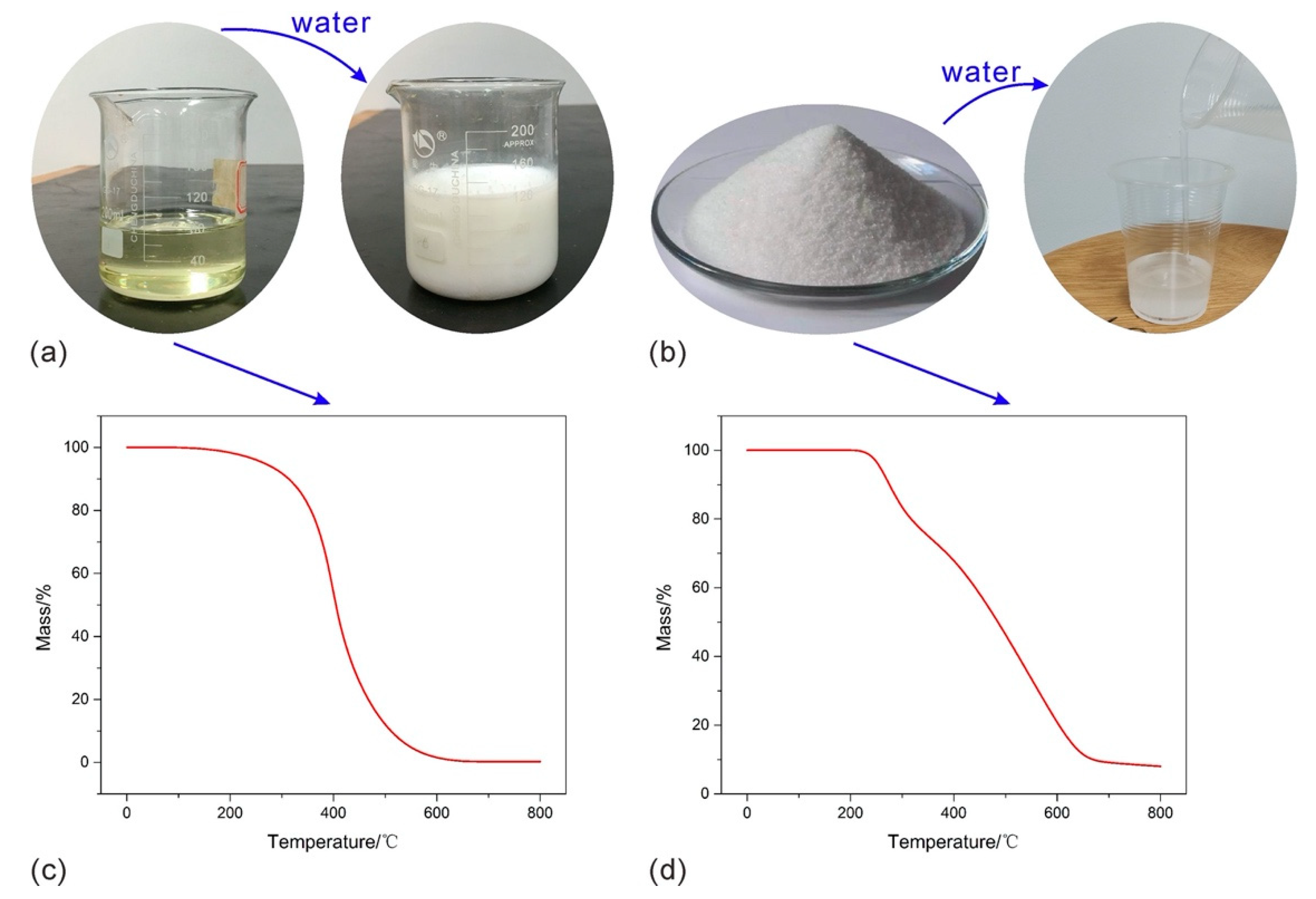




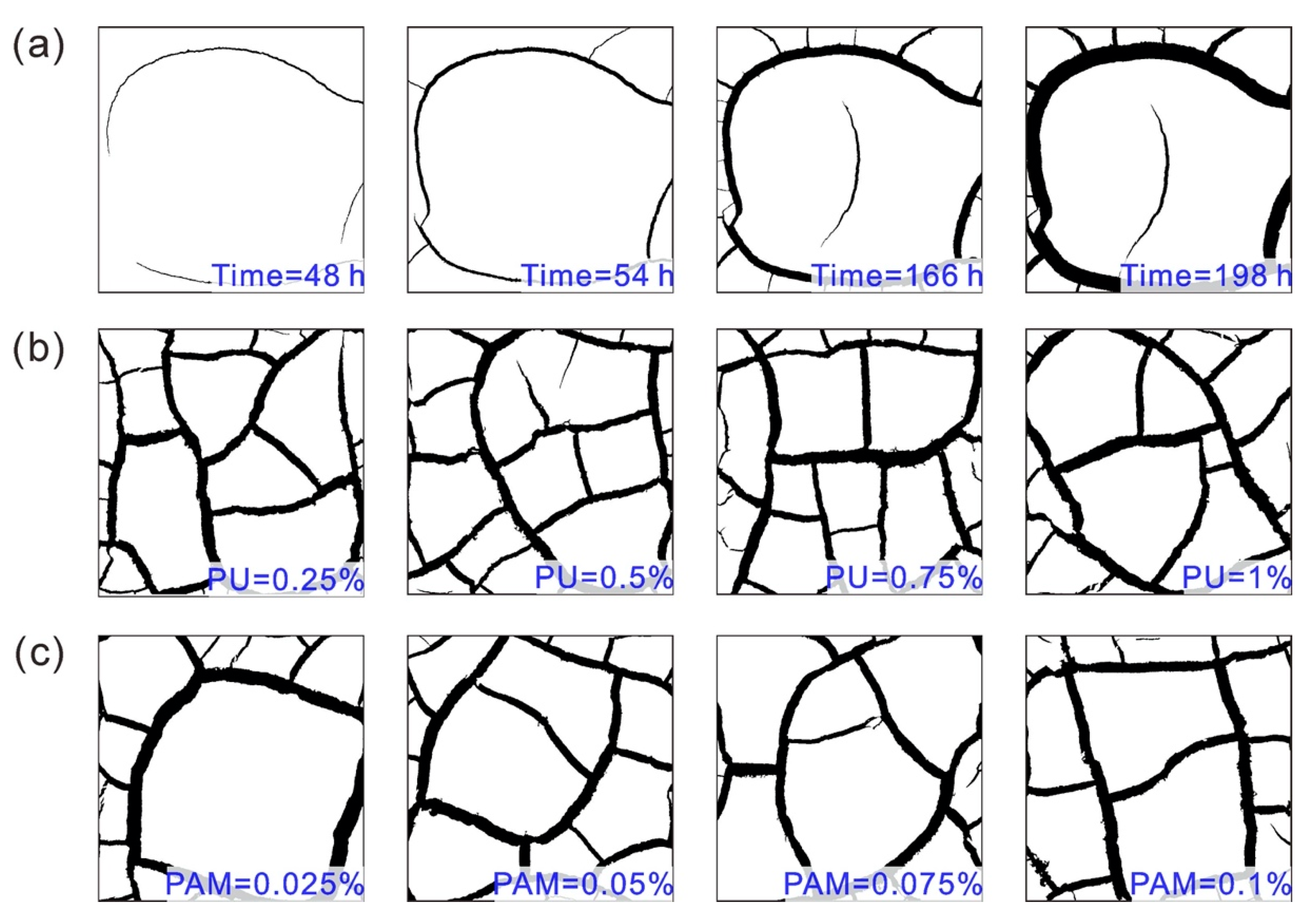


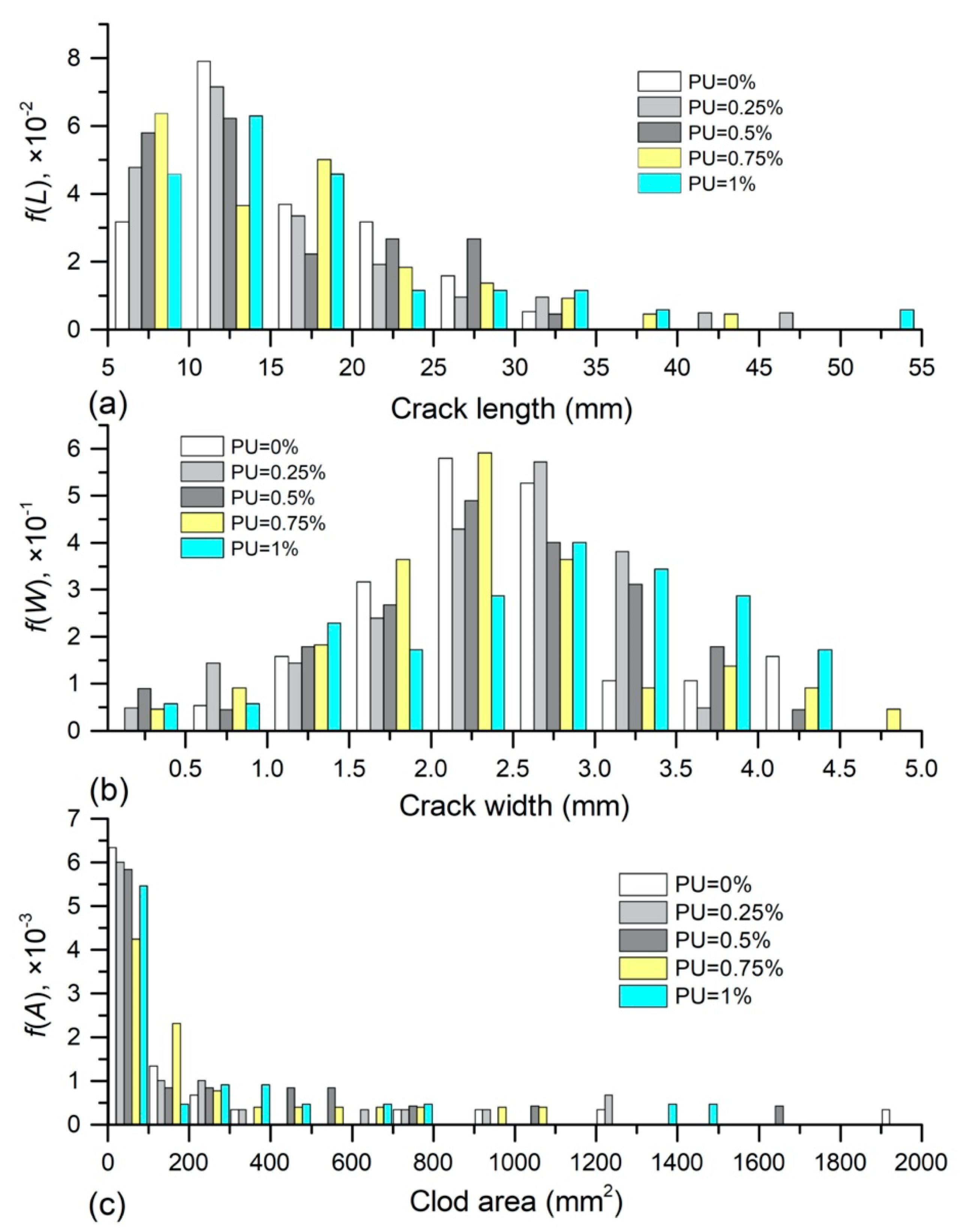

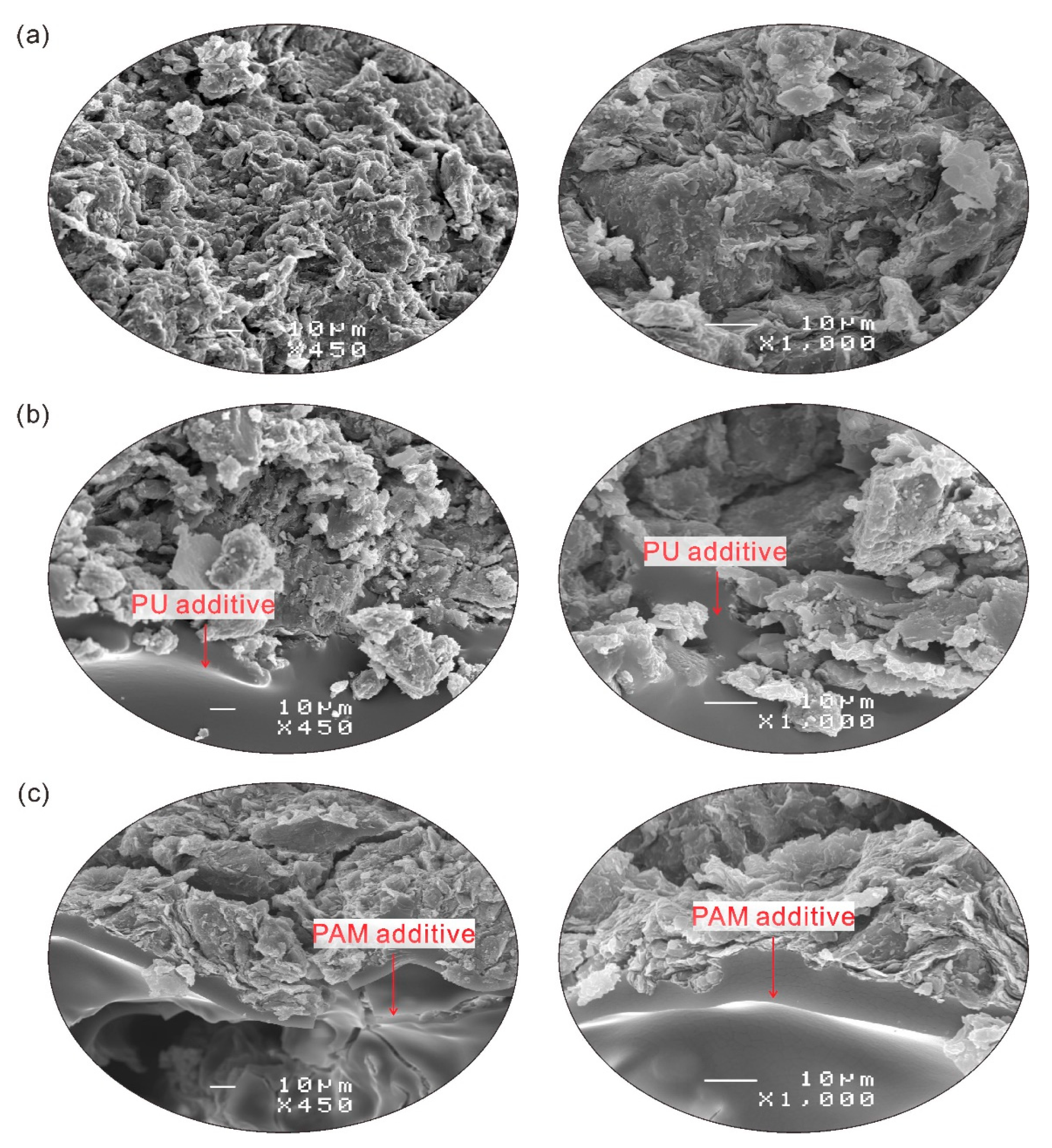

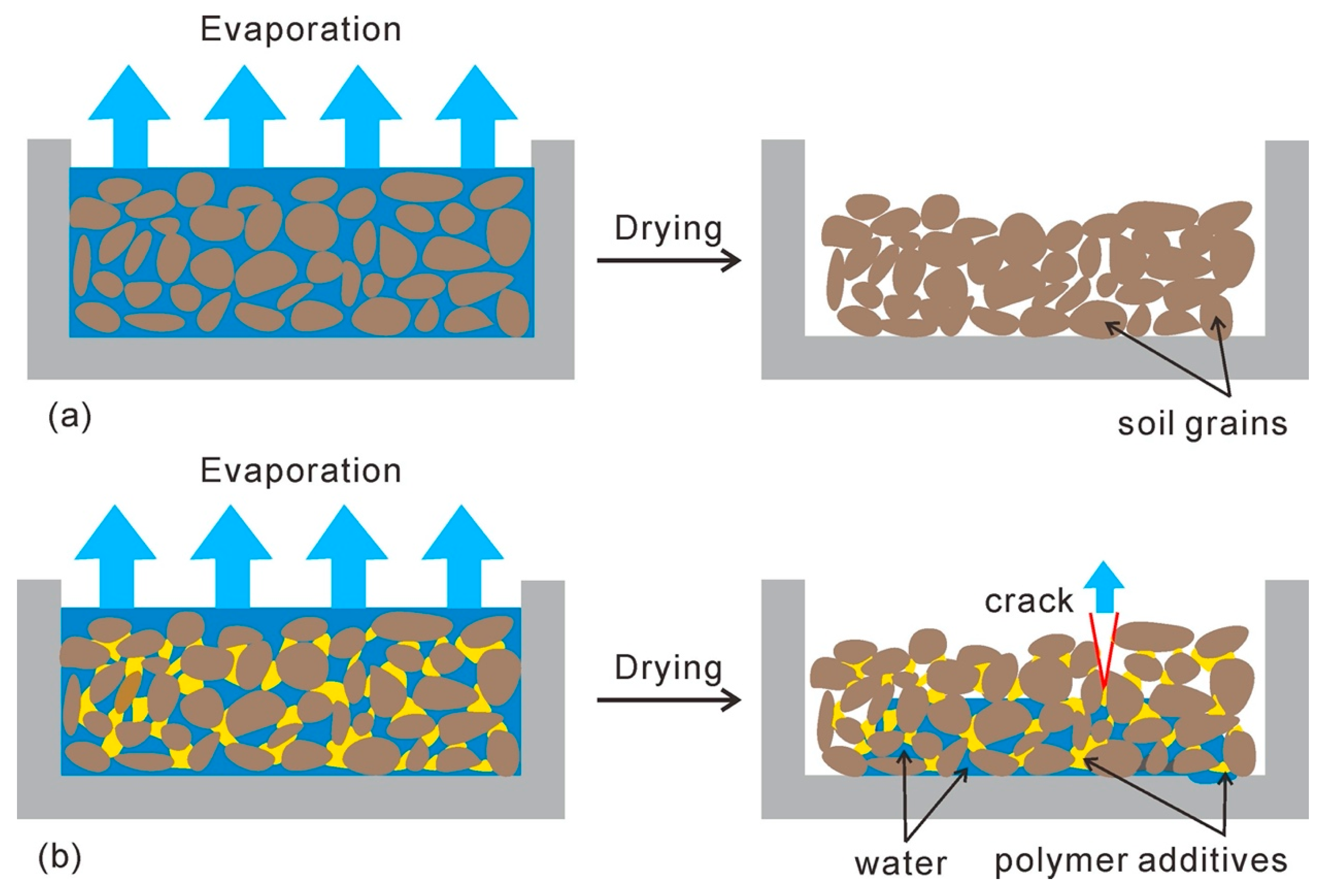
| Item | Value |
|---|---|
| Specific gravity | 2.73 |
| Consistency limit | |
| Liquid limit (%) | 36.7 |
| Plastic limit (%) | 18.9 |
| Plasticity index | 17.8 |
| USCS classification | CL |
Publisher’s Note: MDPI stays neutral with regard to jurisdictional claims in published maps and institutional affiliations. |
© 2020 by the authors. Licensee MDPI, Basel, Switzerland. This article is an open access article distributed under the terms and conditions of the Creative Commons Attribution (CC BY) license (http://creativecommons.org/licenses/by/4.0/).
Share and Cite
Qi, C.; Bai, Y.; Liu, J.; Bu, F.; Kanungo, D.P.; Song, Z.; He, X. Desiccation Cracking Behavior of Polyurethane and Polyacrylamide Admixed Clayey Soils. Polymers 2020, 12, 2398. https://doi.org/10.3390/polym12102398
Qi C, Bai Y, Liu J, Bu F, Kanungo DP, Song Z, He X. Desiccation Cracking Behavior of Polyurethane and Polyacrylamide Admixed Clayey Soils. Polymers. 2020; 12(10):2398. https://doi.org/10.3390/polym12102398
Chicago/Turabian StyleQi, Changqing, Yuxia Bai, Jin Liu, Fan Bu, Debi Prasanna Kanungo, Zezhuo Song, and Xilong He. 2020. "Desiccation Cracking Behavior of Polyurethane and Polyacrylamide Admixed Clayey Soils" Polymers 12, no. 10: 2398. https://doi.org/10.3390/polym12102398
APA StyleQi, C., Bai, Y., Liu, J., Bu, F., Kanungo, D. P., Song, Z., & He, X. (2020). Desiccation Cracking Behavior of Polyurethane and Polyacrylamide Admixed Clayey Soils. Polymers, 12(10), 2398. https://doi.org/10.3390/polym12102398





